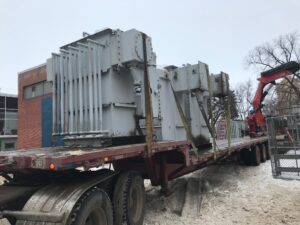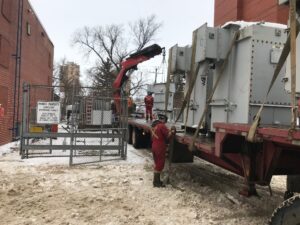Battle of the Sub-Station
Deep in the inner world of Edmonton City Center, was a small building housing a substation complex. Over the years they had filled the basement with lighting arrestors, the main floor with regulators and switches; outside were 2 rows of transformers. The complex was built, or started in 1915, and was a state of the art facility. The day we inspected the site, it was shut down, a victim of the system’s own success. The power needs of the city were beyond the old circuit’s capabilities. It was now an idle building, in a back alley, squeezed between apartment towers and parking lots.
Just getting into the site was going to be an issue. Just a back alley, that dead-ended to the south, and the north entrance was off a bike lane street; a no-fly zone for our heavy units. We could squeeze between the apartments if the parking lots could be controlled. (Good Luck) We ‘could’ get in, just had to arrange a little cooperation from the neighboring apartment dwellers.
The fenced transformer yard had a lane down the middle and the XForms on both sides. There were lines with heavy power in the alley, but avoidable, and on the other side of the alley, thank you Lord for small mercies. A couple of these girls were 12 ft high, and 19,000 lbs, the weight was marked right on the body. There were expansion tanks on the top, those would have to come off. For some of the units we could reach from outside the fence, we needed to remove the top barb wire section but that was easily done. The entire place was being leveled.

Starting to plan
We started to plan the exterior moves first and realized if we removed a few from outside the fence, we would build enough room to get our bigger units thru the gate and be able to slide our trailer in beside the crane. There were 4 trailers of product outside, minimum; so we needed to get in there. To line up our long trailers and get inside the narrow opening we had to come down the alley, travel by the compound, then back up on a slight angle thru a corner of the parking lot to hit the gate. The street access was the bike lane. We checked the next street and the next. None were ideal for accessing an alley off a residential avenue. We were south of 101 av. We decided on 104 av. It was wide, 6-8 lanes, but a zoo of speed demons and jammed up stressed urban commuters. Nothing new there. Fight our way off 104 and plod down the alley cross 3 other streets into the site. We had a start.
We went inside the frigid little brick structure. It was 20 below and there was no heat anywhere inside the building. It felt like the thick concrete and brick walls were a cold sink, dropping the temperature even further. The top floor was lined with switch gears and regulators, large old, machines. Really old, unrecognizable. Both sides of the building were lined solid with them. Some were linked together; and there seemed to be frontal pieces, on wheels, and carts to move them. No one in the room had any experience removing, or installing. Even the oldest hands had never seen them moved. Operated yes, but the dates predated anyone’s birth. I asked a general question to the group. “Does anyone have any idea how to take these things apart.?” We had to get them out of there. ‘Don, all the guys who put these in are dead.’ General laughter followed, very funny. I reported that ‘my mother was 95, I’ll go ask her if she has any ideas’.
We were definitely on our own, but we were working with a great local construction outfit, between us, we would figure it out.
Just when I thought we were done, the group made a frigid journey into the basement. And, oh boy. It was another jam fest down there. And besides the stairs, the only good access was a plate on the floor of the main level to access. At least the main floor access was a wall section that rolled aside. Not at ground level though. The main floor was 4 ft off the ground. For this type of work and our cranes, an elevated landing is a good thing. And the floor plate was just inside the wall opening. Perfect.
We had to reach inside the opening anyway to collect the upper floor switchgear and regulators. Our cranes sit at about 13 ft, the door header was about 8 ft high, add that extra 4 ft and the upper floor removals for our crane, and their low profile setups were going to be a breeze. Some may need a few pieces removed, but we could easily reach inside the sling, and lift.
The basement was a different story. It was filled with old round steel and copper wound lightning arrestors, called chokers. They were over 6 ft high, and stacked and rippled like a stack of large black plates. Each stake was bolted in sections, and there were more cooling lines and valving ringing the walls. The hands said everything in the station was in working order; just too small. It had worked for over a hundred and 5 years; 1915 to 2020; right to the day they shut it off. Amazing.
Time to take the substation down
Now we had to rip it apart, get it up thru the hole in the floor, load on a trailer, and then one last journey to the scrap yard. We realized something else. Most of the pieces in the basement were too tall to lift straight out. By the time we rigged our boom and winch line, shive, and hook, the system was too long to lift the Chokers and make it back out the door. We would have to dismantle the top section. Not to mention roll the rest of the tall black beauties under the opening. But it could be done.
Several of our 25 tonne folding cranes come with winches, that we can attach to our pullouts and still keep a fairly low profile. A Perfect set up for this type of work.
We had a basic plan and then proceeded to comply with Client and site requirements. Drug and alcohol tests for everyone, a full Job Hazard Assessment that covered from leaving our shop to every phase of the removal, and the transportation off-site. Daily on-site job tailgates were mandatory and necessary to cover the daily tasks and changes that inevitably intrude into the workday. Lists of equipment and their certifications; trucks, and cranes. Operator credentials and driver’s license, rigging tickets for our swampers. And a WCB clearance letter for the company. A general quote was issued with the pricing of each unit, on an hourly and daily basis.
There were time restrictions and even though all the equipment was to be drained of any oil, we were required to use drip trays for all the regulators, switch gears, and some of the transformers. We had a number of drip trays and found a supplier for the rest.
The initial work was scheduled for the early fall, but we never started until January. The first lifts were the heavy transformers. We came down the alley and were able to make a hard right turn off the alley in between the apartments and the site. The crane was right beside us, reaching over the fence. It was perfect; and we loaded up quickly and tried to drive out tractor straight out onto the street, slip over a low central divider and take an easy left toward Jasper avenue.
One of the more creative parkers had left his Corolla sticking out so far into the exit, there was no way we could get by. We pulled our unit as close as we could and brought another trailer in to load. We went door to door looking for the owner, rousted the building superintendents. We kept working and the general’s temperature was rising; finally, the driver appeared and we made it off-site.
That delay could have cost us an entire trip, but the recycler was too busy to unload. We dollied our trailer, swung by our yard, and picked up another trailer; already loaded with drip trays, by our yard crew. We were prepared.
Making Progress
By the time we returned with the third trailer we had cleared enough of the courtyard to pull our crane inside and get the back of the trailer in too. As we loaded and opened more space, both the crane and the tractor slid further and further into the compound. The head of safety was there and saw how quickly and easily we were loading with our big knuckles. He asked about the parking clown, wondering why we bothered waiting for the driver to move his vehicle when we had such capable cranes. We knew the answer to that one. “Yes we thought about a little lift action, but then your name came up, and we decided to wait for the driver to show.” It was their job. There was no way we were touching a civilian’s vehicle, and he knew it. All the same, it is a nice relief to have a top safety, and utility man relax a little on-site.
We cleared the entire compound out in a single day, left only a few regulators that we could grab from outside of the far end. We used yet another parking lot, one that empties at 8 am, did our business; and got off-site.
Our friends were wrenching, cutting, and draining the inside gear. We had a two-week break while the winter played with the city and our contractor worked their way thru the top floor and into the basement. We lifted the floor cover off, lowered some gear for the crews, then placed a steel plate of our own over the hole. Our contractor was dismantling the main floor maze and moving everything they could as close to the door as possible. We watched their struggles and supplied some basic jack and roll gear, and rolling hydraulic lift frames to make it easier for them.
Two weeks later, they were ready to remove the product. We came down the alley and set up in front of the building. Our crane extended the low profile pull out, reached in the wall opening and made short work of the stubby, top-heavy switches, and regulators. Soon we had all the drip trays full, the load tied and there was no one blocking the driveway. It was all looking good until we tried to exit the lot and realized a snowplow had driven by and left a 3 ft high windrow in the middle of the street.
Time to get out of there
Thanks a lot, Edmonton. We had a chance to back down the alley, but our second truck was blocking that route. I had shown up on-site in time to realize we couldn’t make the turn onto the street. And that was the ‘only’ route possible. The trees and the buildings make anything but a left turn to the far side of the street, impossible.
I stepped into the street and walked over to the berm. It was a good 3 ft high, and wide too, 4 ft across. I stepped into it and the snow gave a little; it must have been a recent plowing, We had small shovels on the trucks, and a rigger or two. We grabbed the shovels and wailed away on the berm. If we could get thru with the tractor, the trailer might ride right over. But that’s a lot of snow, and as we make the corner, and the trailer swings around; there’s a lot more snow to plow.
We got a bit of a trail opened before we all petered out. Tough work, we had spread snow over the entire street; the tractor might fit thru; the trailer would be a bit of work. I walked back and looked gratefully at the tough old Mack truck the boys had brought over to pull the trailer. It had a mean-looking bumper; it looked perfect for the job at hand.
This was something I needed to shoulder alone. I took a long look at the entrance, shuffled the truck until I had a maximum run at it. 20 ft was all I had and when the boys signaled there was nothing coming, I slid the big Mac into second and bounced into the street with my foot down, the engine roaring, the rear wheels locked up, and a death grip on the wheel. I hit the edge of the berm and there was snow flying; I could feel the weight of the load pushing me and the tires grabbed street then snow. As we slammed thru the berm I pulled the tractor left and as the big boots turned the front, we chewed our way into the full berm. The unit slowed but our momentum and the churning torque blasted the snow out of our way. As we entered the other lane, the trailer pushed the tractor uncomfortably close to the parked cars on the side of the road. I backed off a little throttle and let the unit straighten out; but I needn’t have worried, because at that moment the trailer wheels and the loaded trailer, plowed into the full height of the berm, and that jerked the tractor back into the lane. But the Mack never faltered, the wheels grabbed again and we moved the pile of snow and ice in a slow, spread across the lane, the snow spilled away and we crushed it under our wheels.
We were out.
The next week we had to do it again.
Wrapping up the project
The lifts from the basement were especially challenging because we had so little headroom to work with. (with the winch and shive on) When the crew started dismantling the Chokers, the old construction of them was really interesting. They were steel and copper but mostly held together by grout, and inside the body were long wooden bolts, complete with nuts and washers, all in perfect conditions, and all made of hardwood. Honest, wood; I kept a couple as souvenirs.
It was a week of sporadic work, spread over 3 weeks. Everything went well considering the tight site and the problems we encountered. The very last load was a doozy. We loaded a 48 ft flat deck right to the gunnels, that was the longest unit we could get in there. We got everything down to the last bolt; but it was such a mixture of small pieces, top-heavy regulators, and slippery valves that the run thru the berm; which had been reinforced with a fresh drop of white, was looking a little foolish.

We didn’t want to risk an incident on the final load of the project. It was a struggle but we backed the trailer up and made a tight turn, between the poles, the fences, and the cars; into the alley. We needed to head North to 104th ave, but we were facing South. We were prepared. And we backed up thru the back alley, with a fully stacked, bit high and a bit wide load; our swampers walking beside me pointing out trees, leaning fences, low wires, protruding roofs; for 4 blocks, past women and amazed children, over bike lanes, god bless ’em, cross streets and several homeless wanderers and no we had no cigarettes, and yes we are kind of busy; right to a nice wide street and got turned about to face East and homeward bound.
